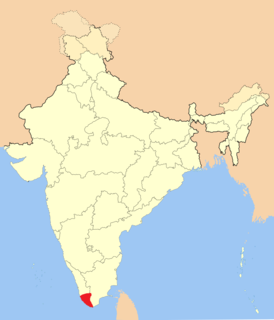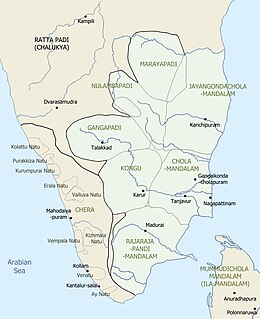Related Research Articles

The Pandya dynasty, also known as the Pandyas of Madurai, was a dynasty of south India, one of the three famous Tamil lineages, the other two being the Chola and the Chera. Extant since at least the 4th to 3rd centuries BC, the dynasty passed through two periods of imperial dominance, the 6th to 10th centuries CE, and under the 'Later Pandyas'. The Pandyas ruled extensive territories, at times including the large portions of present-day south India and northern Sri Lanka through collateral branches subject to Madurai.

The Pallava dynasty was an Indian dynasty that existed from 275 CE to 897 CE, ruling a portion of southern India. They gained prominence after the eclipse of the Satavahana dynasty, whom the Pallavas served as feudatories.

Aditya I, the son of Vijayalaya, was the Chola king who extended the Chola dominions by the conquest of the Pallavas and occupied the Western Ganga Kingdom.

Vijayalaya Chola was a king of South India who founded the imperial Chola Empire. He ruled over the region to the north of the river Kaveri.

Karikala was a Chola dynasty king who ruled southern India. He is credited with the construction of the flood banks of the river Kaveri. He is recognised as the greatest of the Early Cholas.

Rajendra Chola III was a brother and also rival of Rajaraja Chola III who came to the Chola throne in 1246 CE. Although Rajaraja III was still alive, Rajendra began to take effective control over the administration. The epigraphs of Rajendra Chola III indicate a civil war between Rajaraja III and himself which came to end with the former killing the latter and ascending the throne. Rajendra's inscriptions laud him as the "cunning hero, who killed Rajaraja after making him wear the double crown for three years".

Ay was an Indian Yadava dynasty which controlled the south-western tip of the peninsula, from the early historic period up to the medieval period. The clan traditionally held sway over the harbour of Vizhinjam, the fertile region of Nanjinad, and southern parts of the spice-producing Western Ghat mountains. The dynasty was also known as Kupaka in medieval period.
Kadungon was a Pandya king of early historic south India. Kadung + kon or ko (king) meaning "the great king" in tamil. He was also referred as Thennavan. He is chiefly remembered for reviving the Pandya dynastic power in south India. Along with the Pallava king Simhavishnu, he is credited with ending the Kalabhra rule, marking the beginning of a new era in south India.
Maravarman Sundara Pandyan I was a Pandyan king, who ruled regions of South India between 1216–1238 CE. He laid the foundation for the Pandya revival, after being dominated by the Cholas for several centuries.
Maravarman Rajasimha I, also known as Pallavabhanjana, was a Pandya king of early medieval south India. He was the son and successor of Ko Chadaiyan Ranadhira. He remembered for his important successes against the Pallavas and in the Kongu country.
Arikesari Maravarman, also known as Parankusa, was a Pandya king of early medieval south India.
Kochchadaiyan, known as Ranadhira, was a Pandya king of early medieval south India. He was the son and successor of Arikesari Maravarman. The name of the king is famously omitted in the Tamil portion of the Larger Sinnamanur Plates.
Maravarman Rajasimha II was the last major king of the early medieval Pandya kingdom of south India. He was the son and successor of Parantaka Viranarayana. He is the donor of the Larger Sinnamanur Plates.
Maravarman Sundara Pandyan II was a Pandyan king, who ruled regions of South India between 1238–1240 CE.
Battle of Thirupurambiyam was fought between the Pandya king Varagunavarman II and a confederacy of the Pallavas, Western Ganga Dynasty and the Medieval Cholas in about 879 CE near modern-day Kumbakonam. The Pandyas lost the battle with Varagunavarman II going into retirement.
Nedunjeliyan II was the greatest of Early Pandya Kings. He defeated a confederacy of the Cholas and Cheras at Talaiyalanganam near Tiruvarur and conquered most of the Tamil country establishing him as the most important ruler of his time. His deeds have been described in detail in the Maduraikkanci.

Srimara Srivallabha was a Pandya king of early medieval south India.
Maravarman Avanisulamani was a Pandya ruler of early historic south India. He was the son and successor of Kadungon, who revived the Pandya dynastic power after the Kalabhra interregnum. Not much information is available about either of these kings.
Jayantavarman, known in Tamil as Seliyan Sendan, was a Pandya ruler of early historic south India. He is best known for extending the Pandya rule to the Chera country (Kerala). He was succeeded by his son Maravarman Arikesari Parankusan.

Kongu Chera dynasty, or Cheras/Keralas of Kongu or Karur, or simply as the Chera/Kerala dynasty, were a medieval royal lineage in south India, initially ruling over western Tamil Nadu and central Kerala. The headquarters of the Kongu Cheras was located at Karur-Vanchi (Karur) in central Tamil Nadu. The Chera rulers of Kongu were subordinate to or conquered by Chalukya, Pallava and Pandya kings. Rashtrakuta and Chola rulers are also said to have overrun the Kongu Chera country.
References
- ↑ Sastri, K. A. Nilakanta. (1958, second ed.) A History of South India from Prehistoric Times to the Fall of Vijayanagar. Madras, Oxford University Press. 165.
- 1 2 3 Sastri, K. A. Nilakanta. (1929) The Pandyan Kingdom. London, Luzac and Company. 78-79.
- 1 2 Sastri, K. A. Nilakanta. (1958, second ed.) A History of South India from Prehistoric Times to the Fall of Vijayanagar. Madras, Oxford University Press. 153-54.
- 1 2 Noburu Karashima (ed.), A Concise History of South India: Issues and Interpretations. New Delhi: Oxford University Press, 2014. 88-89.
- 1 2 3 4 Sastri, K. A. Nilakanta. (1958, second ed.) A History of South India from Prehistoric Times to the Fall of Vijayanagar. Madras, Oxford University Press. 167-68.